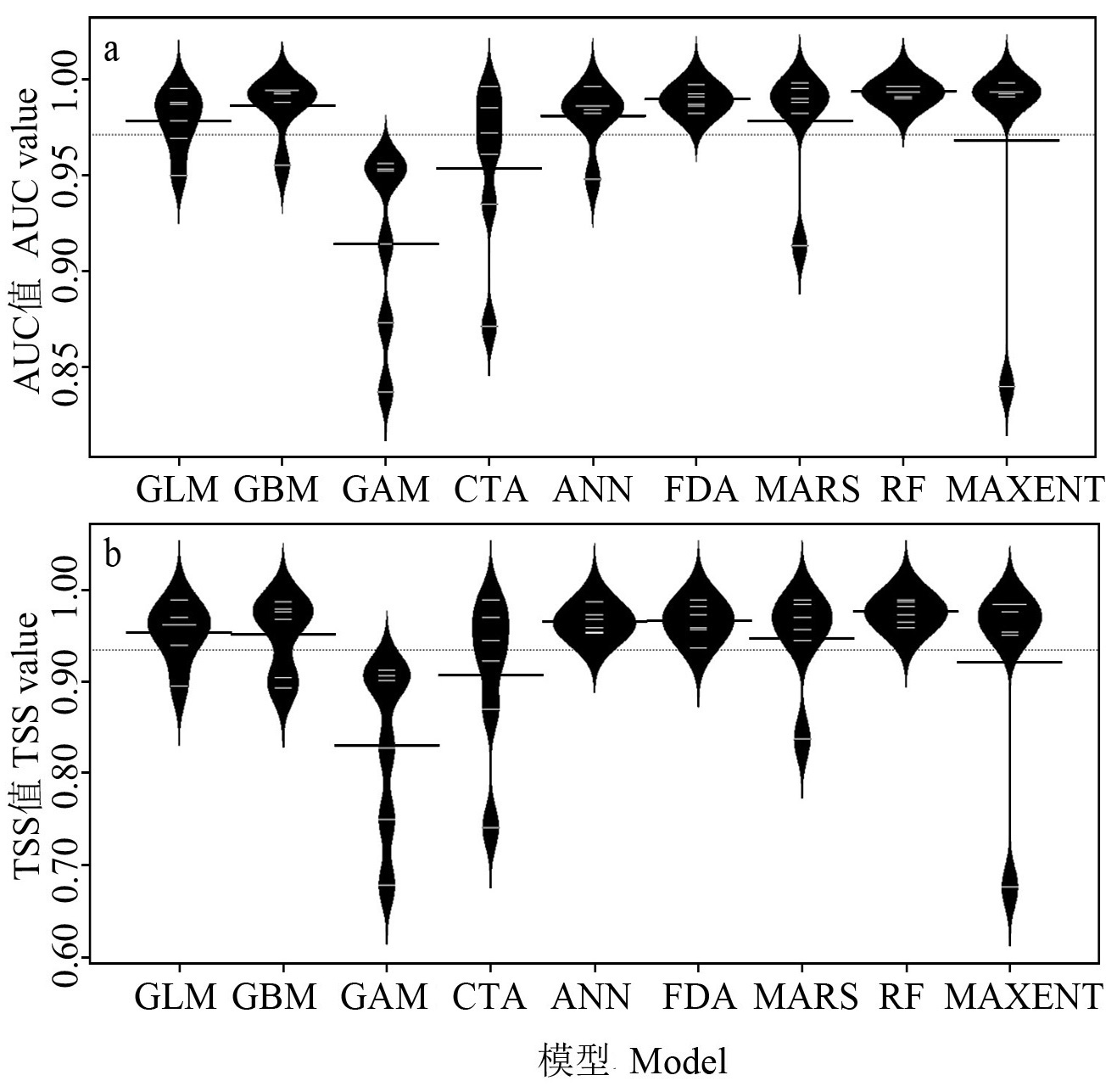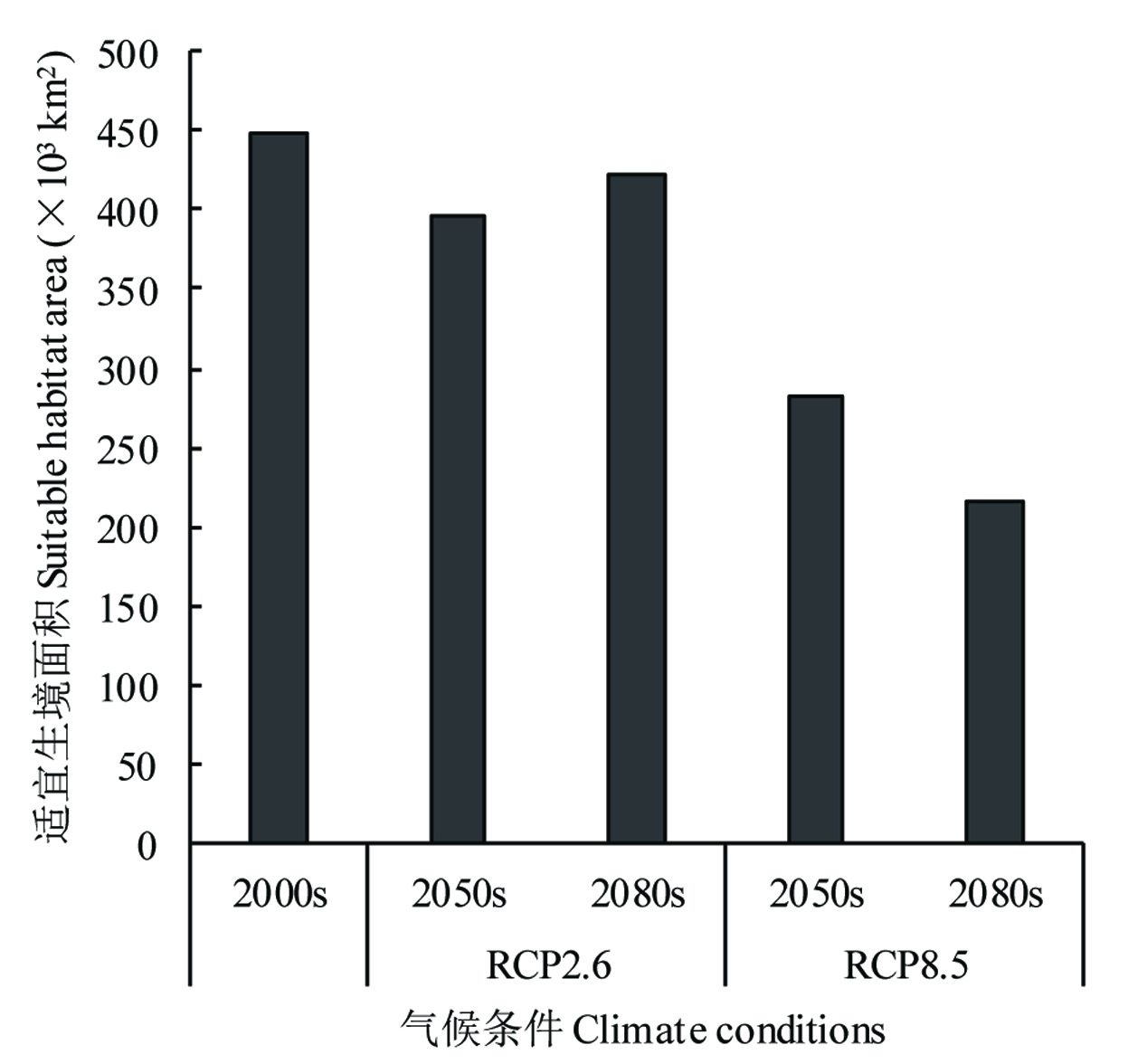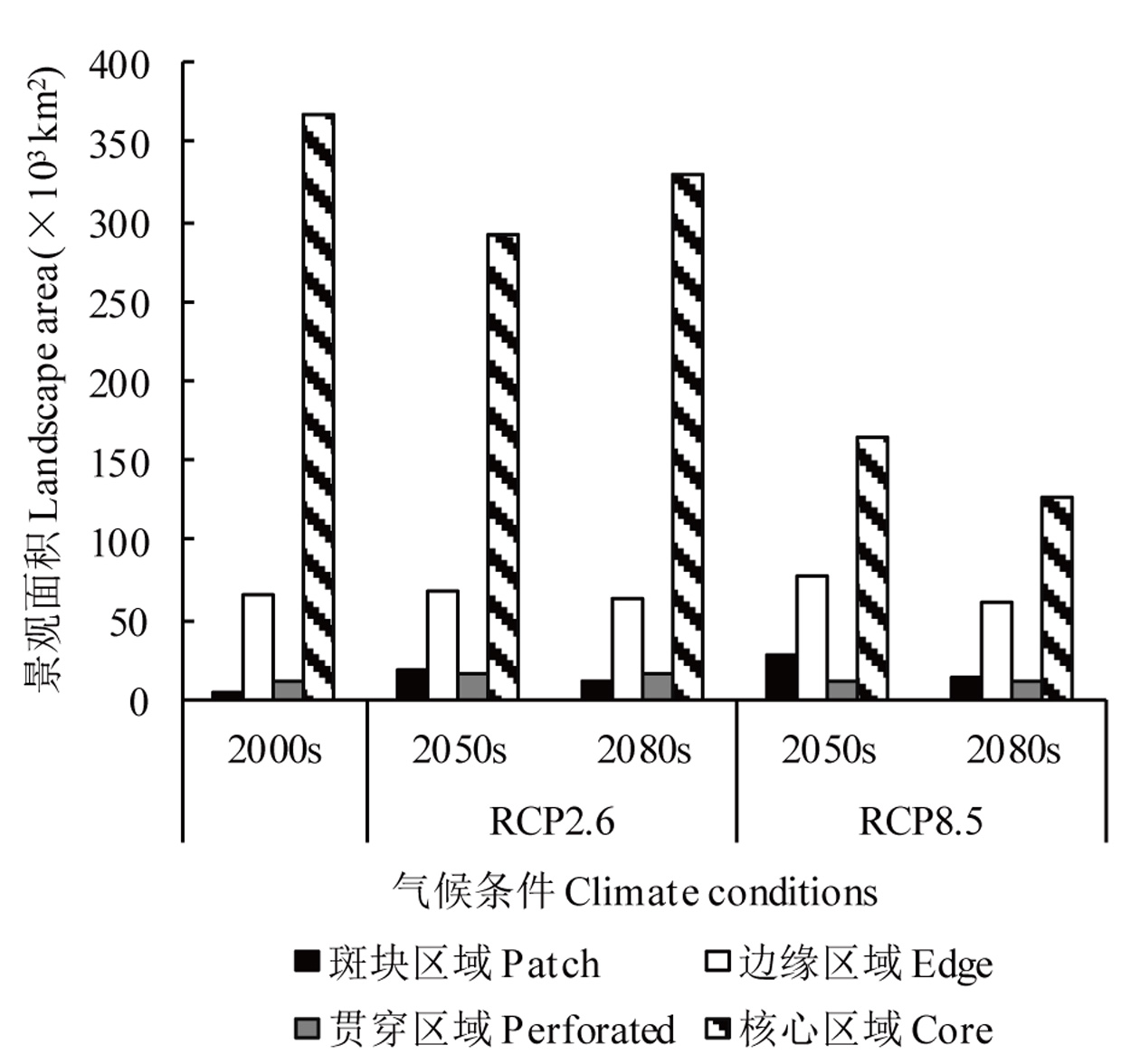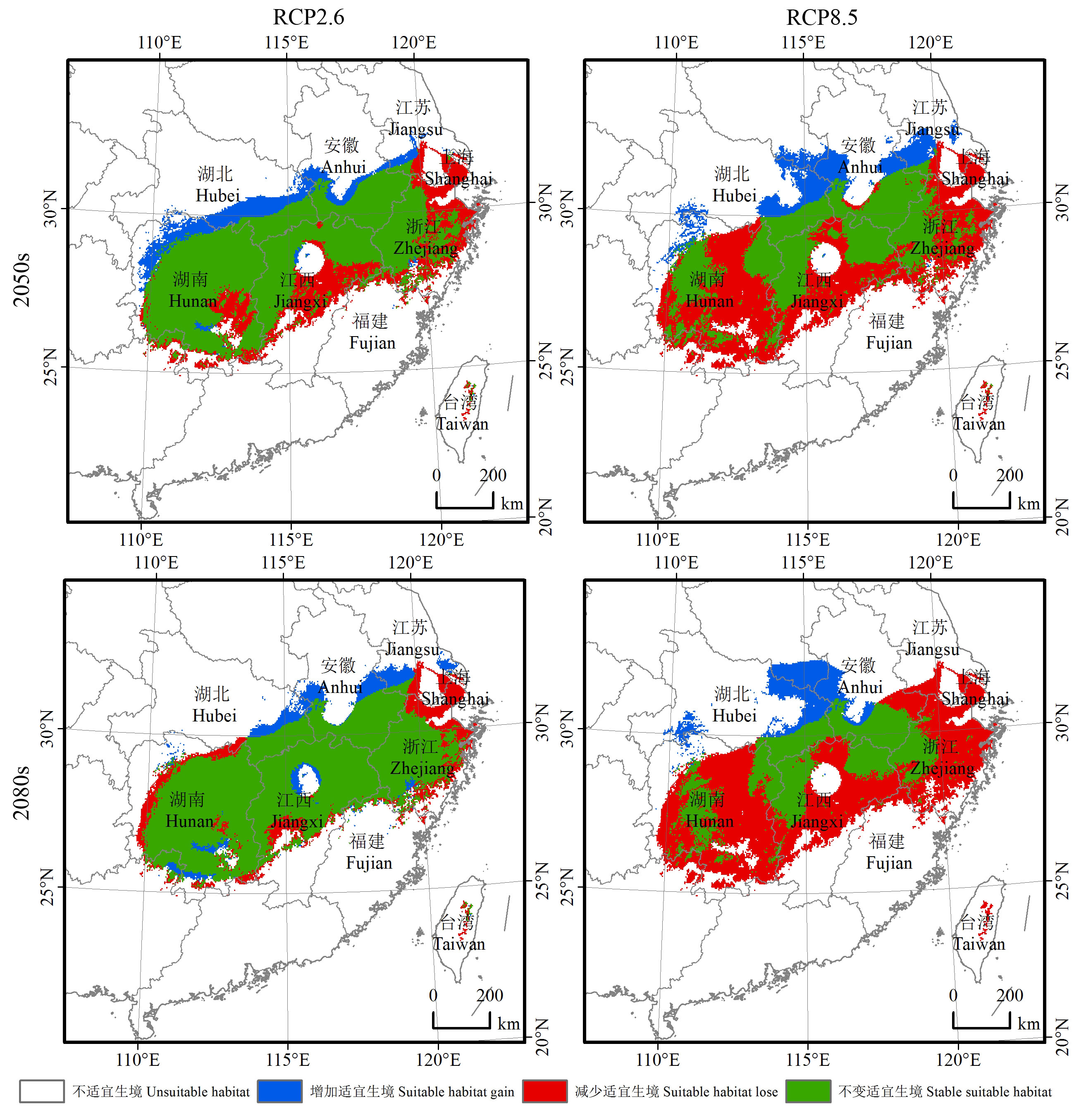



Biodiv Sci ›› 2016, Vol. 24 ›› Issue (12): 1390-1399. DOI: 10.17520/biods.2016152 cstr: 32101.14.biods.2016152
• Original Papers: Animal Diversity • Previous Articles Next Articles
Juncheng Lei1, Sha Wang2, Junwei Wang3, Jun Wu4,*( )
)
Received:2016-06-06
Accepted:2016-11-02
Online:2016-12-20
Published:2017-01-10
Contact:
Wu Jun
Juncheng Lei, Sha Wang, Junwei Wang, Jun Wu. Potential effects of future climate change on suitable habitat of Muntiacus crinifrons, an endangered and endemic species in China[J]. Biodiv Sci, 2016, 24(12): 1390-1399.

Fig. 1 AUC values (a) and TSS values (b) for the nine models in predicting the suitable habitat for Muntiacus crinifrons. GLM, Generalized linear model; GBM, Generalized boosting model; GAM, Generalized additive model; CTA, Classification tree analysis; ANN, Artificial neural networks; FDA, Flexible discriminant analysis; MARS, Multiple adaptive regression splines; RF, Random forest; MAXENT, Maximum entropy.
| 等温性 Isothermality | 温度季节性变化标准差 Standard deviation of temperature seasonality | 最暖月最高温 Max. temperature of warmest month | 最冷月最低温 Min. temperature of coldest month | 最干月 降水量 Precipitation of driest month | 降水量季节性变异系数 Coefficient of varia- tion of precipitation seasonality | |
|---|---|---|---|---|---|---|
| 广义线性模型 Generalized linear model | 14 | 24 | 25 | 60 | 76 | 52 |
| 广义相加模型 Generalized additive model | 52 | 44 | 46 | 45 | 88 | 57 |
| 广义增强模型 Generalized boosting model | 4 | 0 | 0 | 15 | 96 | 1 |
| 分类树分析模型 Classification tree analysis | 9 | 0 | 1 | 10 | 98 | 1 |
| 人工神经网络模型 Artificial neural networks | 23 | 58 | 56 | 63 | 96 | 72 |
| 混合判别式分析模型 Flexible discriminant analysis | 2 | 14 | 13 | 18 | 84 | 0 |
| 多元自适应回归样条函数模型 Multiple adaptive regression splines | 9 | 43 | 10 | 19 | 94 | 6 |
| 随机森林模型 Random forest | 3 | 4 | 3 | 7 | 62 | 7 |
| 最大熵模型 Maximum entropy | 28 | 1 | 12 | 47 | 99 | 13 |
| 平均 Average | 16 | 21 | 18 | 31 | 88 | 23 |
Table 1 Importance of each climatic factor to the distribution of Muntiacus crinifrons based on the Jackknife method (%)
| 等温性 Isothermality | 温度季节性变化标准差 Standard deviation of temperature seasonality | 最暖月最高温 Max. temperature of warmest month | 最冷月最低温 Min. temperature of coldest month | 最干月 降水量 Precipitation of driest month | 降水量季节性变异系数 Coefficient of varia- tion of precipitation seasonality | |
|---|---|---|---|---|---|---|
| 广义线性模型 Generalized linear model | 14 | 24 | 25 | 60 | 76 | 52 |
| 广义相加模型 Generalized additive model | 52 | 44 | 46 | 45 | 88 | 57 |
| 广义增强模型 Generalized boosting model | 4 | 0 | 0 | 15 | 96 | 1 |
| 分类树分析模型 Classification tree analysis | 9 | 0 | 1 | 10 | 98 | 1 |
| 人工神经网络模型 Artificial neural networks | 23 | 58 | 56 | 63 | 96 | 72 |
| 混合判别式分析模型 Flexible discriminant analysis | 2 | 14 | 13 | 18 | 84 | 0 |
| 多元自适应回归样条函数模型 Multiple adaptive regression splines | 9 | 43 | 10 | 19 | 94 | 6 |
| 随机森林模型 Random forest | 3 | 4 | 3 | 7 | 62 | 7 |
| 最大熵模型 Maximum entropy | 28 | 1 | 12 | 47 | 99 | 13 |
| 平均 Average | 16 | 21 | 18 | 31 | 88 | 23 |

Fig. 3 Areas of suitable habitats for Muntiacus crinifrons under various climate conditions. RCP2.6 represents radiative forcing peaks at approximately 3 W/m2 before 2100, while RCP8.5 represents radiative forcing reaches > 8.5 W/m2 by 2100.

Fig. 4 Landscape composition of suitable habitats for Muntiacus crinifrons under various climate conditions. RCP2.6 represents radiative forcing peaks at approximately 3 W/m2 before 2100, while RCP8.5 represents radiative forcing reaches > 8.5 W/m2 by 2100.

Fig. 5 Spatial changes of suitable habitats for Muntiacus crinifrons under various climate scenarios. RCP2.6 represents radiative forcing peaks at approximately 3 W/m2 before 2100, while RCP8.5 represents radiative forcing reaches > 8.5 W/m2 by 2100.
| [11] | Chen X, Jiang K, Bao Y, Wang H, Shi W, Zheng W, Liu J (2015) The mating system study of black muntjac (Muntiacus crinifrons) based on fecal DNA. Acta Ecologica Sinica, 35, 137-141. |
| [12] | Cheng HY, Bao YX, Chen L, Zhou XW, Hu ZY, Ge BM (2008) Genetic diversity of the black muntjac Muntiacus crinifrons population in the central area of Anhui and Zhejiang Province. Acta Zoologica Sinica, 54, 96-103.(in Chinese with English abstract) |
| [程宏毅, 鲍毅新, 陈良, 周襄武, 胡知渊, 葛宝明 (2008) 黑麂皖-浙分布中心种群的遗传多样性. 动物学报,54, 96-103.] | |
| [13] | Cheng SL, Yuan RB, Zou SC (2013) Black muntjac (Muntiacus crinifrons) found in Wuyishan, Jiangxi. Acta Theriologica Sinica, 33, 94.(in Chinese) |
| [程松林, 袁荣斌, 邹思成 (2013) 江西武夷山发现黑麂. 兽类学报,33, 94.] | |
| [14] | Cheng SL, Zou SC, Yuan RB (2012) Preliminary report of Muntiacus crinifrons and its habitat survey in Wuyishan National Natural Reserve, Jiangxi, China. Jiangxi Science, 30, 594-598.(in Chinese with English abstract) |
| [程松林, 邹思成, 袁荣斌 (2012) 江西武夷山国家级自然保护区黑麂及其生境调查初报. 江西科学,30, 594-598.] | |
| [15] | Cohen J (1960) A coefficient of agreement for nominal scales. Educational and Psychological Measurement, 20, 37-46. |
| [16] | Dawson TP, Jackson ST, House JI, Prentice IC, Mace GM (2011) Beyond predictions: biodiversity conservation in a changing climate. Science, 332, 53-58. |
| [17] | Elith J, Graham CH, Anderson RP, Dudík M, Ferrier S, Guisan A, Hijmans RJ, Huettmann F, Leathwick JR, Lehmann A, Li J, Lohmann LG, Loiselle BA, Manion G, Moritz C, Nakamura M, Nakazawa Y, Overton JM, Peterson AT, Phillips ST, Richardson K, Scachetti-Pereira R, Schapire RE, Soberón J, Williams S, Wisz MS, Zimmermann NE (2006) Novel methods improve prediction of species’ distributions from occurrence data. Ecography, 29, 129-151. |
| [18] | Elith J, Leathwick JR (2009) Species distribution models: ecological explanation and prediction across space and time. Annual Review of Ecology, Evolution,and Systematics, 40, 677-697. |
| [19] | Environmental Systems Research Institute (ESRI) (2009) ArcGIS Desktop 9.3 help. (accessed on 2016-04-15 |
| [20] | Giovanelli JGR, de Siqueira MF, Haddad CFB, Alexandrino J (2010) Modeling a spatially restricted distribution in the Neotropics: how the size of calibration area affects the performance of five presence-only methods? Ecological Modelling, 221, 215-224. |
| [21] | Guisan A, Thuiller W (2005) Predicting species distribution: offering more than simple habitat models. Ecology Letters, 8, 993-1009. |
| [22] | Guo QH, Liu Y (2010) ModEco: an integrated software package for ecological niche modeling. Ecography, 33, 1-6. |
| [23] | Hijmans RJ, Cameron SE, Parra JL, Jones PG, Jarvis A (2005) Very high resolution interpolated climate surfaces for global land areas. International Journal of Climatology, 25, 1965-1978. |
| [24] | Hole DG, Huntley B, Arinaitwe J, Butchart SH, Collingham YC, Fishpool LD, Pain DJ, Willis SG (2011) Toward a management framework for networks of protected areas in the face of climate change. Conservation Biology, 25, 305-315. |
| [25] | Hu JH, Jiang Z (2011) Climate change hastens the conservation urgency of an endangered ungulate. PLoS ONE, 6, e22873. |
| [26] | IPCC (Intergovernmental Panel on Climate Change) (2014)Climate Change 2014: Synthesis Report. . (accessed on 2016-02-20 |
| [27] | Jiménez-Valverde A, Lobo JM (2007) Threshold criteria for conversion of probability of species presence to either-or presence-absence. Acta Oecologica, 31, 361-369. |
| [28] | Lei JC (2014) Study on the Change Characteristics of Suitable Habitat for Sichuan Hill-Partridge and Identification of the Critical Conserve Region under Future Climate Change. PhD dissertation, Nanjing Forestry University, Nanjing.(in Chinese with English abstract) |
| [雷军成 (2014) 气候变化情景下四川山鹧鸪适宜生境变化特征研究与保护关键区识别.博士学位论文, 南京林业大学, 南京.] | |
| [29] | Lei JC, Xu HG, Wu J, Guan QW (2015) IPCC AR5-based analysis of variation of potential suitable habitats for evergreen broadleaf forest in China. Journal of Ecology and Rural Environment, 31(1), 69-76.(in Chinese with English abstract) |
| [雷军成, 徐海根, 吴军, 关庆伟 (2015) 基于IPCC AR5的我国常绿阔叶林潜在适宜生境变化分析. 生态与农村环境学报,31(1), 69-76.] | |
| [30] | Li L, Chen JK (2014) Influence of climate change on wild plants and the conservation strategies. Biodiversity Science, 22, 549-563.(in Chinese with English abstract) |
| [黎磊, 陈家宽 (2014) 气候变化对野生植物的影响及保护对策. 生物多样性,22, 549-563.] | |
| [31] | Liu H, Wang W, Song G, Qu Y, Li S, Fjeldså J, Lei F (2012) Interpreting the process behind endemism in China by integrating phylogeography and ecological niche models of the Stachyridopsis ruficeps. PLoS ONE, 7, e46761. |
| [32] | Liu J, Linderman M, Ouyang Z, An L, Yang J, Zhang H (2001) Ecological degradation in protected areas: the case of Wolong Nature Reserve for giant pandas. Science, 292, 98-101. |
| [33] | Liu X, Guo Z, Ke ZW, Wang SP, Li YM (2011) Increasing potential risk of a global aquatic invader in Europe in contrast to other continents under future climate change. PLoS ONE, 6, e18429. |
| [34] | Liu YZ, Shi LL, Duo HR, Peng BY, Lü C, Zhu Y, Lei GC (2013) Disturbance-driven changes to landscape patterns and responses of waterbirds at West Dongting Lake, China. Biodiversity Science, 21, 666-676.(in Chinese with English abstract) |
| [刘云珠, 史林鹭, 朵海瑞, 彭波涌, 吕偲, 朱轶, 雷光春 (2013) 人为干扰下西洞庭湖湿地景观格局变化及冬季水鸟的响应. 生物多样性,21, 666-676.] | |
| [35] | Luo Z, Jiang Z, Tang S (2015) Impacts of climate change on distributions and diversity of ungulates on the Tibetan Plateau. Ecological Applications, 25, 24-38. |
| [36] | Moritz C, Agudo R (2013) The future of species under climate change: resilience or decline? Science, 341, 504-508. |
| [37] | Olson LE, Sauder JD, Albrecht NM, Vinkey RS, Cushman SA, Schwartz MK (2014) Modeling the effects of dispersal and patch size on predicted fisher (Pekania [Martes] pennanti) distribution in the US Rocky Mountains. Biological Conservation, 169, 89-98. |
| [38] | Parmesan C, Yohe G (2003) A globally coherent fingerprint of climate change impacts across natural systems. Nature, 421, 37-42. |
| [39] | Pearson RG, Dawson TP (2003) Predicting the impacts of climate change on the distribution of species: are bioclimate envelope models useful? Global Ecology and Biogeography, 12, 361-371. |
| [40] | Qiao H, Soberón J, Peterson AT (2015) No silver bullets in correlative ecological niche modelling: insights from testing among many potential algorithms for niche estimation. Methods in Ecology and Evolution, 6, 1126-1136. |
| [41] | Qiao HJ, Hu JH, Huang JH (2013) Theoretical basis, future directions, and challenges for ecological niche models. Scientia Sinica Vitae, 43, 915-927.(in Chinese with English abstract) |
| [乔慧捷, 胡军华, 黄继红 (2013) 生态位模型的理论基础、发展方向与挑战. 中国科学: 生命科学,43, 915-927.] | |
| [42] | Thuiller W (2004) Patterns and uncertainties of species’ range shifts under climate change. Global Change Biology, 10, 2020-2027. |
| [43] | Thuiller W, Lafourcade B, Engler R, Araújo MB (2009) BIOMOD—a platform for ensemble forecasting of species distributions. Ecography, 32, 369-373. |
| [1] | Allouche O, Tsoar A, Kadmon R (2006) Assessing the accuracy of species distribution models: prevalence, kappa and the true skill statistic (TSS). Journal of Applied Ecology, 43, 1223-1232. |
| [2] | Aranda SC, Lobo JM (2011) How well does presence-only- based species distribution modelling predict assemblage diversity? A case study of the Tenerife flora. Ecography, 34, 31-38. |
| [3] | Araújo MB, Peterson AT (2012) Uses and misuses of bioclimatic envelope modeling. Ecology, 93, 1527-1539. |
| [44] | Vogt P, Riitters KH, Estreguil C, Kozak J, Wade TG, Wickham JD (2007) Mapping spatial patterns with morphological image processing. Landscape Ecology, 22, 171-177. |
| [45] | Walther G, Post E, Convey P, Menzel A, Parmesan C, Beebee TJC, Fromentin J, Hoegh-Guldberg O, Bairlein F (2002) Ecological responses to recent climate change. Nature, 416, 389-395. |
| [46] | Wang S (1998) China Red Data Book of Endangered Animals: Mammalia. Science Press, Beijing.(in Chinese) |
| [汪松 (1998) 中国濒危动物红皮书: 兽类. 科学出版社, 北京.] | |
| [4] | Austin MP, Van Niel KP (2011) Improving species distribution models for climate change studies: variable selection and scale. Journal of Biogeography, 38, 1-8. |
| [5] | Barbet-Massin M, Jiguet F, Albert CH, Thuiller W (2012) Selecting pseudo-absences for species distribution models: how, where and how many? Methods in Ecology and Evolution, 3, 327-338. |
| [6] | Biomod Team (2012) BIOMOD: Tutorial.. (accessed on 2016-05- 04 |
| [47] | Wu JG, Wang L, Yang YW, Dai SF, Liu JQ, Zhu G (2011) Nature reserve need to face the challenge of climate change. Environmental Protection, (4), 30-32.(in Chinese) |
| [吴建国, 王亮, 杨永伟, 代拴发, 刘建泉, 朱高 (2011) 自然保护区还需面对气候变化挑战. 环境保护, (4), 30-32.] | |
| [7] | Braunisch V, Coppes J, Arlettaz R, Suchant R, Schmid H, Bollmann K (2013) Selecting from correlated climate variables: a major source of uncertainty for predicting species distributions under climate change. Ecography, 36, 971-983. |
| [8] | Brown JL, Yoder AD (2015) Shifting ranges and conservation challenges for lemurs in the face of climate change. Ecology and Evolution, 5, 1131-1142. |
| [48] | Wu WW, Xu HG, Wu J, Cao MC (2012) The impact of climate change on birds: a review. Biodiversity Science, 20, 108-115.(in Chinese with English abstract) |
| [吴伟伟, 徐海根, 吴军, 曹铭昌 (2012) 气候变化对鸟类影响的研究进展. 生物多样性,20, 108-115.] | |
| [9] | CBD (Convention on Biological Diversity) (2014) Global Biodiversity Outlook 4 . (accessed on 2016-02-22) |
| [10] | Chen L, Bao YX, Zhang LL, Cheng HY, Zhang JY, Zhou YQ (2010) Seasonal changes in habitat selection by black muntjac (Muntiacus crinifrons) in Jiulong Mountain Nature Reserve. Acta Ecologica Sinica, 30, 1227-1237.(in Chinese with English abstract) |
| [49] | Xu WH, Yue XL, Gao P, Xia SJ (2013) Potential ecological habitat of Muntiacus crinifrons within National Nature Reserve of Mount Tianmu, Zhejiang Province. Journal of Zhejiang A & F University, 30, 896-903.(in Chinese with English abstract) |
| [徐文辉, 岳晓雷, 高鹏, 夏淑娟 (2013) 天目山国家级自然保护区黑麂潜在栖息地的生态适宜性. 浙江农林大学学报,30, 896-903.] | |
| [50] | Zhai TQ, Li XH (2012) Climate change induced potential range shift of the crested ibis based on ensemble models. Acta Ecologica Sinica, 32, 2361-2370.(in Chinese with English abstract) |
| [翟天庆, 李欣海 (2012) 用组合模型综合比较的方法分析气候变化对朱鹮潜在生境的影响. 生态学报,32, 2361-2370.] | |
| [51] | Zhang F, Dong M, Wu TW (2014) Evaluation of the ENSO features simulations as done by the CMIP5 models. Acta Meteorologica Sinica, 72, 30-48.(in Chinese with English abstract) |
| [张芳, 董敏, 吴统文 (2014) CMIP5模式对ENSO现象的模拟能力评估. 气象学报,72, 30-48.] | |
| [52] | Zhang HR, Cai XH (2008) Research advances in landscape pattern and dynamics. Journal of Southwest Forestry College, 28, 23-28.(in Chinese with English abstract) |
| [张会儒, 蔡小虎 (2008) 景观格局动态研究进展. 西南林学院学报,28, 23-28.] | |
| [53] | Zhang YL, Hu ZJ, Qi W, Wu X, Bai WQ, Li LH, Ding MJ, Liu LS, Wang ZF, Zheng D (2015) Assessment of protection effectiveness of nature reserves on the Tibetan Plateau based on net primary production and the large-sample-comparison method. Acta Geographica Sinica, 70, 1027-1040.(in Chinese with English abstract) |
| [张镱锂, 胡忠俊, 祁威, 吴雪, 摆万奇, 李兰晖, 丁明军, 刘林山, 王兆锋, 郑度 (2015) 基于NPP数据和样区对比法的青藏高原自然保护区保护成效分析. 地理学报,70, 1027-1040.] | |
| [54] | Zheng WC, Liu J, Pan CC, Bao YX, Lin JJ (2012) Review of research on black muntjac (Muntiacus crinifrons), an endemic species in China. Chinese Journal of Wildlife, 33, 283-288.(in Chinese with English abstract) |
| [郑伟成, 刘军, 潘成椿, 鲍毅新, 林杰君 (2012) 中国特有动物黑麂的研究. 野生动物,33, 283-288.] | |
| [55] | Zhong GP, Shen WJ, Wan FH, Wang JJ (2009) Potential distribution areas of Solanum rostratum in China: a prediction with GARP niche model. Chinese Journal of Ecology, 28, 162-166.(in Chinese with English abstract) |
| [钟艮平, 沈文君, 万方浩, 王进军 (2009) 用GARP生态位模型预测刺萼龙葵在中国的潜在分布区. 生态学杂志,28, 162-166.] | |
| [56] | Zhu GP, Liu GQ, Bu WJ, Gao YB (2013) Ecological niche modeling and its applications in biodiversity conservation. Biodiversity Science, 21, 90-98.(in Chinese with English abstract) |
| [朱耿平, 刘国卿, 卜文俊, 高玉葆 (2013) 生态位模型的基本原理及其在生物多样性保护中的应用. 生物多样性,21, 90-98.] | |
| [10] | [陈良, 鲍毅新, 张龙龙, 程宏毅, 张家银, 周元庆 (2010) 九龙山保护区黑麂栖息地选择的季节变化. 生态学报,30, 1227-1237.] |
| [1] | Yan Kang Jing Gan Linlin Yu Chenjing He Jingbin Wu Liqing Zhang. Design pattern and network development of urban microhabitat based on natural-based solutions (NbS): A case study of habitat gardens in Changning District, Shanghai [J]. Biodiv Sci, 2025, 33(5): 24528-. |
| [2] | Jing Gan Xiangxu Liu Xueming Lu Xing Yue. China's Large Cities in Global Biodiversity Hotspots: Conservation Policies and Optimization Directions [J]. Biodiv Sci, 2025, 33(5): 24529-. |
| [3] | Zixuan Zeng Rui Yang Yue Huang Luyao Chen. Characteristics of bird diversity and environmental relationships in Tsinghua University campus [J]. Biodiv Sci, 2025, 33(5): 24373-. |
| [4] | Hao Zhou, Mingyi Wang, Chuge Zhang, Zhishu Xiao, Fang Ouyang. The status and challenges of insect hotels in the conservation of urban solitary bees and wasps diversity [J]. Biodiv Sci, 2025, 33(5): 24472-. |
| [5] | Xiaoyu Zhu, Chenhao Wang, Zhongjun Wang, Yujun Zhang. Research progress and prospect of urban green space biodiversity [J]. Biodiv Sci, 2025, 33(5): 25027-. |
| [6] | Xin Wang, Femgyu Bao. Analysis of the ecological restoration effect of South Dianchi National Wetland Park based on the enhancement of bird diversity [J]. Biodiv Sci, 2025, 33(5): 24531-. |
| [7] | Yue Ming, Peiyao Hao, Lingqian Tan, Xi Zheng. A study on urban biodiversity conservation and enhancement in china based on the concept of green and high-quality development of cities [J]. Biodiv Sci, 2025, 33(5): 24524-. |
| [8] | Huan Xu, Fengfei Xin, Hongliang Shi, Lin Yuan, Shunqi Bo, Xinyi Zhao, Shuaitao Deng, Tingting Pan, Jing Yu, Saisai Sun, Cheng Xue. Evaluation of effects of integrated ecological restoration technology on habitat and bird diversity improvement in the northern branch of Yangtze River Estuary [J]. Biodiv Sci, 2025, 33(5): 24478-. |
| [9] | Murong Yi, Ping Lu, Yong Peng, Yong Tang, Jiuheng Xu, Haoping Yin, Luyang Zhang, Xiaodong Weng, Mingxiao Di, Juan Lei, Chenqi Lu, Rujun Cao, Nianhua Dai, Deyang Zhan, Mei Tong, Zhiming Lou, Yonggang Ding, Jing Chai, Jing Che. Population status and habitat of Critically Endangered Jiangxi giant salamander (Andrias jiangxiensis) [J]. Biodiv Sci, 2025, 33(4): 24145-. |
| [10] | Motong Li, Tuo He, Wei Li, Jing Liao, Yan Zeng. Regulating international trade in wild fauna and flora: An analysis of CITES terminology [J]. Biodiv Sci, 2025, 33(4): 24545-. |
| [11] | Mingyi Zhang, Xiaomei Wang, Yanxin Zheng, Nan Wu, Donghao Li, Enyuan Fan, Na Li, Xiujuan Shan, Tao Yu, Chunnuan Zhao, Bo Li, Shuai Xu, Yuping Wu, Liqun Ren. Resource status and habitat function of typical oyster reef areas in the Yellow River Estuary [J]. Biodiv Sci, 2025, 33(4): 24208-. |
| [12] | Xiaoqiang Lu, Shanshan Dong, Yue Ma, Xu Xu, Feng Qiu, Mingyue Zang, Yaqiong Wan, Luanxin Li, Cigang Yu, Yan Liu. Current status, challenges, and prospects of frontier technologies in biodiversity conservation applications [J]. Biodiv Sci, 2025, 33(4): 24440-. |
| [13] | Guo Yutong, Li Sucui, Wang Zhi, Xie Yan, Yang Xue, Zhou Guangjin, You Chunhe, Zhu Saning, Gao Jixi. Coverage and distribution of national key protected wild species in China’s nature reserves [J]. Biodiv Sci, 2025, 33(3): 24423-. |
| [14] | Zhao Weiyang, Wang Wei, Ma Bingran. Advances and prospects in research on other effective area-based conservation measures (OECMs) [J]. Biodiv Sci, 2025, 33(3): 24525-. |
| [15] | Zhou Zhihua, Jin Xiaohua, Luo Ying, Li Diqiang, Yue Jianbing, Liu Fang, He Tuo, Li Xi, Dong Hui, Luo Peng. Analyses and suggestions on mechanisms of forestry and grassland administrations in China to achieve targets of Kunming-Montreal Global Biodiversity Framework [J]. Biodiv Sci, 2025, 33(3): 24487-. |
| Viewed | ||||||
|
Full text |
|
|||||
|
Abstract |
|
|||||
Copyright © 2022 Biodiversity Science
Editorial Office of Biodiversity Science, 20 Nanxincun, Xiangshan, Beijing 100093, China
Tel: 010-62836137, 62836665 E-mail: biodiversity@ibcas.ac.cn ![]()